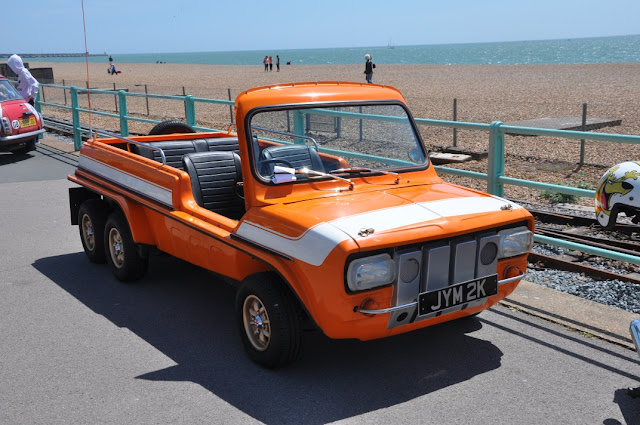It all starts on a run down farm in Chichester, Sussex, England. While living in a motor-home, Barry Stimson hatched the idea of creating a mini based beach buggy. Working all hours of the night, the first thing to come out of his work shop was a one inch box section chassis. It was powered by a motor from a £10 scrap Mini panel van. Not more than a week later the first Mini Bug was born. It was the epitome of "D.I.Y." initiative...
Stimson named his company "Design Developments" and offered his Mini Bug for sale at £170. It came in three colors; Red, Blue, and Yellow. Extra's included a plastic screen, which was bent and formed over a converted electric heating element made by Barry. One could also have a rollover bar at the cost of £8. A full "factory built" kit was also available.
 |
| Barry Stimson in an early Mini Bug |
The Safari 6 was a development of Stimson's next endeavor, Barrian Cars Ltd. This BMC Mini-based, six-wheeled creation made its initial debut on the British "Tomorrow's World" TV show in 1971. However, it was not officially shown until late 1972 at the International Trade Fair in Malta.
 |
| Note the unusual wiper on the original Safari 6, with Stimson at the helm |
The prototype had an odd windshield wiper arrangement, mounted in the top of the windscreen. It also featured an opening tail-gate and a grille similar to the MK2 Mini Bug. The Safari 6 was 12 feet long and its rear track width exceeded the standard Mini's by a foot. It had a load capacity of over 700lbs and a lockable boot in the floor.
Two versions were made, which differed in minor details. The MK1 had the aforementioned wiper system and a twin bumper bar at the front. The MK2 had standard Mini Wipers and a single bumper bar.
 |
| The MK2 Safari 6, note the single bumper bar and normal wipers |
The Safari 6 was not sold in kit form. It was offered as a "turn-key", factory assembled vehicle with a re-conditioned 850cc engine and transaxle for £800.00, or £600.00 sans drivetrain. It came in a choice of three colors; Yellow, Cream, and (Red)Orange. They were made at Barrian Cars' London factory from 1971 to 1973.
The molds were ultimately sold to Shikari Cars Ltd. in Lampeter, South Wales in 1974. They intended to relaunch the "6" and rename it the "Shikari". It was redesigned to use Ford Crossflow engine from the Ford Fiesta of the day. They began work on a Blue prototype in late 1975, built on a modified floor pan, to accommodate the new drivetrain. Only one was made, which was never finished, and the company stopped trading in 1983.
 |
| The Shikari prototype, in an unfinished state |
In total, a fitting number of six Safari 6's were completed, one of which (an MK1) found its way to the USA. The rest remain in the UK.
After operating under a number of corporate entities and producing a wide variety of Mini-based vehicles, including the 3-wheeled Stimson Scorcher, Barry went on to become a consultant for J. Evans & Sons Ltd, of Portsmouth in late 1976. There he designed Honda TNT, truck-based vehicles. He also managed to persuade his new employer to produce his CS+2 buggy briefly.
Some of his designs remained in production, via various subsequent owners of his original molds, as late as 1985. Stimson himself had another go at it from 2002-2007, making modern Fiesta based buggies, a scooter based 3-wheeler, and an electric model.
 |
| In a ring of its kind, on the Mini 25th celebration at Donington, UK |
In the end, Stimson created an interesting and whimsical legacy of vehicles based on the Mini, which are celebrated to this day, among Mini fans, alongside their iconic donor.
Sources:
Paul Wylde
Wikipedia
 |
| The Safari 6 Mk1 in a promo picture, from above |
 |
| The Safari 6 Mk1 in a promo picture |
 |
| Safari 6 Mk2, shown with the full soft-top |
 |
| The Safari 6 Mk2, with partial soft-top installed |
 |
| The Safari 6 Mk2 |
 |
| The Safari 6 Mk2 in Orange |
 |
| The Safari 6 Mk2, sans bumper bars |
 |
| Vintage ad for the Safari 6 |
 |
| The Safari 6 Mk2 with partial soft-top attached |
 |
| The Safari 6 Mk2, with framing for its soft-top shown |
 |
| Stimson's Mini Bug |
 |
| The Safari 6 Mk2 at the NEC Classic Car Show 2019 |






















Comments
Post a Comment